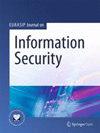Mining digital identity insights: patent analysis using NLP
IF 2.5
Q2 COMPUTER SCIENCE, INFORMATION SYSTEMS
引用次数: 0
Abstract
The field of digital identity innovation has grown significantly over the last 30 years, with over 6000 technology patents registered worldwide. However, many questions remain about who controls and owns our digital identity and intellectual property and, ultimately, where the future of digital identity is heading. To investigate this further, this research mines digital identity patents and explores core themes such as identity, systems, privacy, security, and emerging fields like blockchain, financial transactions, and biometric technologies, utilizing natural language processing (NLP) methods including part-of-speech (POS) tagging, clustering, topic classification, noise reduction, and lemmatisation techniques. Finally, the research employs graph modelling and statistical analysis to discern inherent trends and forecast future developments. The findings significantly contribute to the digital identity landscape, identifying key players, emerging trends, and technological progress. This research serves as a valuable resource for academia and industry stakeholders, aiding in strategic decision-making and investment in emerging technologies and facilitating navigation through the dynamic realm of digital identity technologies.挖掘数字身份洞察力:利用 NLP 进行专利分析
在过去的 30 年里,数字身份创新领域取得了长足的发展,在全球范围内注册了 6000 多项技术专利。然而,关于谁控制和拥有我们的数字身份和知识产权,以及最终数字身份的未来走向,仍然存在许多问题。为了进一步研究这个问题,本研究利用自然语言处理(NLP)方法,包括语音部分(POS)标记、聚类、主题分类、降噪和词法化技术,挖掘数字身份专利,探索身份、系统、隐私、安全等核心主题,以及区块链、金融交易和生物识别技术等新兴领域。最后,研究采用图形建模和统计分析法来辨别内在趋势和预测未来发展。研究结果为数字身份领域做出了重要贡献,确定了主要参与者、新兴趋势和技术进步。这项研究为学术界和行业利益相关者提供了宝贵的资源,有助于战略决策和新兴技术投资,并为数字身份技术的动态领域提供导航。
本文章由计算机程序翻译,如有差异,请以英文原文为准。
求助全文
约1分钟内获得全文
求助全文
来源期刊

EURASIP Journal on Information Security
COMPUTER SCIENCE, INFORMATION SYSTEMS-
CiteScore
8.80
自引率
0.00%
发文量
6
审稿时长
13 weeks
期刊介绍:
The overall goal of the EURASIP Journal on Information Security, sponsored by the European Association for Signal Processing (EURASIP), is to bring together researchers and practitioners dealing with the general field of information security, with a particular emphasis on the use of signal processing tools in adversarial environments. As such, it addresses all works whereby security is achieved through a combination of techniques from cryptography, computer security, machine learning and multimedia signal processing. Application domains lie, for example, in secure storage, retrieval and tracking of multimedia data, secure outsourcing of computations, forgery detection of multimedia data, or secure use of biometrics. The journal also welcomes survey papers that give the reader a gentle introduction to one of the topics covered as well as papers that report large-scale experimental evaluations of existing techniques. Pure cryptographic papers are outside the scope of the journal. Topics relevant to the journal include, but are not limited to: • Multimedia security primitives (such digital watermarking, perceptual hashing, multimedia authentictaion) • Steganography and Steganalysis • Fingerprinting and traitor tracing • Joint signal processing and encryption, signal processing in the encrypted domain, applied cryptography • Biometrics (fusion, multimodal biometrics, protocols, security issues) • Digital forensics • Multimedia signal processing approaches tailored towards adversarial environments • Machine learning in adversarial environments • Digital Rights Management • Network security (such as physical layer security, intrusion detection) • Hardware security, Physical Unclonable Functions • Privacy-Enhancing Technologies for multimedia data • Private data analysis, security in outsourced computations, cloud privacy
 求助内容:
求助内容: 应助结果提醒方式:
应助结果提醒方式:


